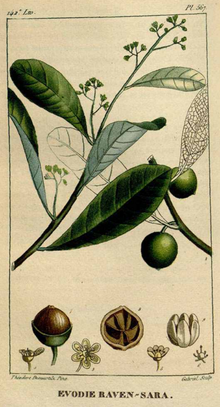Cryptocarya agathophylla
| Cryptocarya agathophylla | |
|---|---|

| |
| Scientific classification | |
| Kingdom: | Plantae |
| Clade: | Tracheophytes |
| Clade: | Angiosperms |
| Clade: | Magnoliids |
| Order: | Laurales |
| Family: | Lauraceae |
| Genus: | Cryptocarya |
| Species: | C. agathophylla
|
| Binomial name | |
| Cryptocarya agathophylla van der Werff
| |
| Synonyms[2] | |
| |
Cryptocarya agathophylla (known in Madagascar as ravintsara and sometimes called clove nutmeg) is a member of the laurel family, Lauraceae, and originates in Madagascar.
Malagasy names include tavolobelelo,[1] havozo, hazomanitra and tavolomanitra. The former genus name Ravensara is a latinization of the Malagasy word ravintsara.[3]
Description
[edit]Cryptocarya agathophylla is a small to medium-sized tree, growing up to 15 meters high.[1] The leaves and twigs of C. agathophylla have a mildly camphorous aroma similar to eucalyptus.
Range and habitat
[edit]Cryptocarya agathophylla is endemic to Madagascar. It grows in humid and subhumid lowland forests and lower montane forests and secondary vegetation between 10 and 1,300 meters elevation.[1]
It is known from 11 locations in the central and eastern parts of Bongolava, Vatovavy Analanjirofo and Alaotra-Mangoro regions. Its estimated extent of occurrence (EOO) is 116,739 km2, the minimum area of occupancy (AOO) is 56 km2.[1]
Conservation and threats
[edit]The species' population is decreasing, and its conservation status is Near Threatened. It is threatened by habitat loss, principally from shifting agriculture, and also from logging, mining, and grazing.[1]
Essential oil
[edit]The essential oil of C. agathophylla is used as a fragrance material in the perfumery industry, and as an antiseptic, anti-viral, antibacterial, expectorant, anti-infective in natural and folk medicine.[4] Primary aromatic components are:[citation needed]
- limonene 19.38%
- sabinene 11.40%
- methyl chavicol 7.94%
- α-pinene 5.55%
- linalool 5.26%
- methyl eugenol 5.00%
- germacrene d 4.76%
- terpinen-4-ol 4.00%
- e-caryophyllene 3.54%
- δ-3-carene 3.52%
- myrcene 3.43%
- α-terpinene 2.98%
- β-pinene 2.91%
- γ-terpinene 2.15%
- α-phellandrene 1.99%
- camphene 1.33%
- (z)-β-ocimene 1.30%
- α-thujene 1.13%
- 1,8-cineole 1.08%
- para-cymene 0.97%
- α-humulene 0.79%
- α-copaene 0.69%
- β-elemene 0.63%
- δ-cadinene 0.60%
- terpinolene 0.56%
- δ-elemene 0.55%
- α-cubebene 0.47%
- α-terpineol 0.38%
- α-guaiene 0.37%
- bornyl acetate 0.36%
- elemol 0.34%
- elemicin 0.23%
- γ-muurolene 0.22%
- borneol 0.21%
- bicyclogermacrene 0.20%
- γ-cadinene 0.19%
- (e)-β-ocimene 0.19%
- β-cubebene 0.16%
- eugenol 0.12%
- α-muurolene 0.11%
- δ-amorphene 0.10%
- α-eudesmol 0.10%
- cis-para-menth-2-en-1-ol 0.10%
- ortho-cymene 0.09%
- β-selinene 0.09%
- β-bourbonene 0.08%
- trans-cadina-1,4-diene 0.08%
- trans-para-menth-2-en-1-ol 0.08%
- cis-sabinene hydrate 0.08%
- trans-sabinene hydrate 0.08%
- caryophyllene oxide 0.07%
- β-copaene 0.07%
- germacrene b 0.07%
- cis-muurola-3,5-diene 0.07%
- trans-cadina-1(6),4-diene 0.06%
- γ-eudesmol 0.06%
- β-eudesmol 0.05%
- guaiol 0.05%
References
[edit]- ^ a b c d e f Rakotonirina, N. 2020. Cryptocarya agathophylla. The IUCN Red List of Threatened Species 2020: e.T137583298A137900098. https://dx.doi.org/10.2305/IUCN.UK.2020-3.RLTS.T137583298A137900098.en. Accessed 28 August 2022.
- ^ Cryptocarya agathophylla van der Werff Plants of the World Online, Kew Science. Accessed 27 August 2022.
- ^ Halpern, Georges M., Weverka, Peter The Healing Trail: Essential Oils of Madagascar, Basic Health Publications Inc., Laguna Beach CA, 2003, pp. 54.
- ^ Andrianjafinandrasana, S.N.; Andrianoelisoa, H.S.; Jeanson, M.L.; Ramonta, I.; Danthu, P. (2013). "Allelopathic effects of volatile compounds of essential oil from Ravensara aromatica Sonnerat chemotypes". Allelopathy Journal. 31 (2): 333–344 – via ResearchGate.

